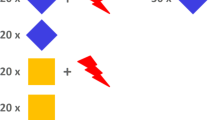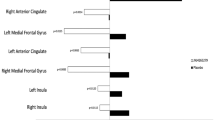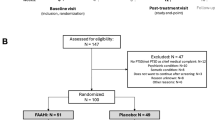Abstract
Recent reports have demonstrated that disruption of CB1 receptor signaling impairs extinction of learned responses in conditioned fear and Morris water maze paradigms. Here, we test the hypothesis that elevating brain levels of the endogenous cannabinoid anandamide through either genetic deletion or pharmacological inhibition of its primary catabolic enzyme fatty-acid amide hydrolase (FAAH) will potentiate extinction in a fixed platform water maze task. FAAH (−/−) mice and mice treated with the FAAH inhibitor OL-135, did not display any memory impairment or motor disruption, but did exhibit a significant increase in the rate of extinction. Unexpectedly, FAAH-compromised mice also exhibited a significant increase in acquisition rate. The CB1 receptor antagonist SR141716 (rimonabant) when given alone had no effects on acquisition, but disrupted extinction. Additionally, SR141716 blocked the effects of OL-135 on both acquisition and extinction. Collectively, these results indicate that endogenous anandamide plays a facilitatory role in extinction through a CB1 receptor mechanism of action. In contrast, the primary psychoactive constituent of marijuana, Δ9-tetrahydrocannabinol, failed to affect extinction rates, suggesting that FAAH is a more effective target than a direct acting CB1 receptor agonist in facilitating extinction. More generally, these findings suggest that FAAH inhibition represents a promising pharmacological approach to treat psychopathologies hallmarked by an inability to extinguish maladaptive behaviors, such as post-traumatic stress syndrome and obsessive-compulsive disorder.
Similar content being viewed by others
Log in or create a free account to read this content
Gain free access to this article, as well as selected content from this journal and more on nature.com
or
References
Beltramo M, di Tomaso E, Piomelli D (1997). Inhibition of anandamide hydrolysis in rat brain tissue by (E)-6-(bromomethylene) tetrahydro-3-(1-naphthalenyl)-2H-pyran-2-one. FEBS Lett 403: 263–267.
Bilkei-Gorzo A, Racz I, Valverde O, Otto M, Michel K, Sastre M et al (2005). Early age-related cognitive impairment in mice lacking cannabinoid CB1 receptors. Proc Natl Acad Sci USA 102: 15670–15675.
Boger DL, Miyauchi H, Du W, Hardouin C, Fecik RA, Cheng H et al (2005). Discovery of a potent, selective, and efficacious class of reversible alpha-ketoheterocycle inhibitors of fatty acid amide hydrolase effective as analgesics. J Med Chem 48: 1849–1856.
Calignano A, La Rana G, Giuffrida A, Piomelli D (1998). Control of pain initiation by endogenous cannabinoids. Nature 394: 277–281.
Chang L, Luo L, Palmer JA, Sutton S, Wilson SJ, Barbier AJ et al (2006). Inhibition of fatty acid amide hydrolase produces analgesia by multiple mechanisms. Br J Pharmacol 47: 1812–1822.
Chhatwal JP, Davis M, Maguschak KA, Ressler KJ (2005). Enhancing cannabinoid neurotransmission augments the extinction of conditioned fear. Neuropsychopharmacology 30: 516–524.
Clement AB, Hawkins EG, Lichtman AH, Cravatt BF (2003). Increased seizure susceptibility and proconvulsant activity of anandamide in mice lacking fatty acid amide hydrolase. J Neurosci 23: 3916–3923.
Cravatt BF, Demarest K, Patricelli MP, Bracey MH, Giang DK, Martin BR et al (2001). Supersensitivity to anandamide and enhanced endogenous cannabinoid signaling in mice lacking fatty acid amide hydrolase. Proc Natl Acad Sci USA 98: 9371–9376.
Cravatt BF, Giang DK, Mayfield SP, Boger DL, Lerner RA, Gilula NB (1996). Molecular characterization of an enzyme that degrades neuromodulatory fatty-acid amides. Nature 384: 83–87.
da Silva GE, Takahashi RN (2002). SR 141716A prevents delta 9-tetrahydrocannabinol-induced spatial learning deficit in a Morris-type water maze in mice. Prog Neuropsychopharmacol Biol Psychiatry 26: 321–325.
Di Marzo V, Goparaju SK, Wang L, Liu J, Batkai S, Jarai Z et al (2001). Leptin-regulated endocannabinoids are involved in maintaining food intake. Nature 410: 822–825.
Ferrari F, Ottani A, Vivoli R, Giuliani D (1999). Learning impairment produced in rats by the cannabinoid agonist HU 210 in a water-maze task. Pharmacol Biochem Behav 64: 555–561.
Gerdeman GL, Ronesi J, Lovinger DM (2002). Postsynaptic endocannabinoid release is critical to long-term depression in the striatum. Nat Neurosci 5: 446–451.
Glaser ST, Abumrad NA, Fatade F, Kaczocha M, Studholme KM, Deutsch DG (2003). Evidence against the presence of an anandamide transporter. Proc Natl Acad Sci USA 100: 4269–4274.
Gobbi G, Bambico FR, Mangieri R, Bortolato M, Campolongo P, Solinas M et al (2005). Antidepressant-like activity and modulation of brain monoaminergic transmission by blockade of anandamide hydrolysis. Proc Natl Acad Sci USA 102: 18620–18625.
Gonzalez S, Cascio MG, Fernandez-Ruiz J, Fezza F, Di Marzo V, Ramos JA (2002). Changes in endocannabinoid contents in the brain of rats chronically exposed to nicotine, ethanol or cocaine. Brain Res 954: 73–81.
Hillard CJ, Jarrahian A (2005). Accumulation of anandamide: Evidence for cellular diversity. Neuropharmacology 48: 1072–1078.
Hoffman AF, Oz M, Caulder T, Lupica CR (2003). Functional tolerance and blockade of long-term depression at synapses in the nucleus accumbens after chronic cannabinoid exposure. J Neurosci 23: 4815–4820.
Holt S, Comelli F, Costa B, Fowler CJ (2005). Inhibitors of fatty acid amide hydrolase reduce carrageenan-induced hind paw inflammation in pentobarbital-treated mice: comparison with indomethacin and possible involvement of cannabinoid receptors. Br J Pharmacol 146: 467–476.
Huang YC, Wang SJ, Chiou LC, Gean PW (2003). Mediation of amphetamine-induced long-term depression of synaptic transmission by CB1 cannabinoid receptors in the rat amygdala. J Neurosci 23: 10311–10320.
Jarrahian A, Manna S, Edgemond WS, Campbell WB, Hillard CJ (2000). Structure-activity relationships among N-arachidonylethanolamine (Anandamide) head group analogues for the anandamide transporter. J Neurochem 74: 2597–2606.
Kathuria S, Gaetani S, Fegley D, Valino F, Duranti A, Tontini A et al (2003). Modulation of anxiety through blockade of anandamide hydrolysis. Nat Med 9: 76–81.
Lambert DM, Fowler CJ (2005). The endocannabinoid system: drug targets, lead compounds, and potential therapeutic applications. J Med Chem 48: 5059–5087.
Ledent C, Valverde O, Cossu G, Petitet F, Aubert JF, Beslot F et al (1999). Unresponsiveness to cannabinoids and reduced addictive effects of opiates in CB1 receptor knockout mice. Science 283: 401–404.
Lichtman AH, Leung D, Shelton CC, Saghatelian A, Hardouin C, Boger DL et al (2004a). Reversible inhibitors of fatty acid amide hydrolase that promote analgesia: evidence for an unprecedented combination of potency and selectivity. J Pharmacol Exp Ther 311: 441–448.
Lichtman AH, Sheikh SM, Loh HH, Martin BR (2001). Opioid and cannabinoid modulation of precipitated withdrawal in delta(9)-tetrahydrocannabinol and morphine-dependent mice. J Pharmacol Exp Ther 298: 1007–1014.
Lichtman AH, Shelton CC, Advani T, Cravatt BF (2004b). Mice lacking fatty acid amide hydrolase exhibit a cannabinoid receptor-mediated phenotypic hypoalgesia. Pain 109: 319–327.
Marsicano G, Goodenough S, Monory K, Hermann H, Eder M, Cannich A et al (2003). CB1 cannabinoid receptors and on-demand defense against excitotoxicity. Science 302: 84–88.
Marsicano G, Wotjak CT, Azad SC, Bisogno T, Rammes G, Cascio MG et al (2002). The endogenous cannabinoid system controls extinction of aversive memories. Nature 418: 530–534.
Myers KM, Davis M (2002). Behavioral and neural analysis of extinction. Neuron 36: 567–584.
Pamplona FA, Takahashi RN (2006). WIN 55212-2 impairs contextual fear conditioning through the activation of CB1 cannabinoid receptors. Neurosci Lett 397: 88–92.
Rescorla RA (2001). Experimental extinction. In: Mowrer RR, Klein SB (eds). Handbook of Contemporary Learning Theories. Erlbaum: Mahawah, NJ. pp 119–155.
Ressler KJ, Rothbaum BO, Tannenbaum L, Anderson P, Graap K, Zimand E et al (2004). Cognitive enhancers as adjuncts to psychotherapy: use of D-cycloserine in phobic individuals to facilitate extinction of fear. Arch Gen Psychiatry 61: 1136–1144.
Richardson JD, Aanonsen L, Hargreaves KM (1998). Hypoactivity of the spinal cannabinoid system results in NMDA-dependent hyperalgesia. J Neurosci 18: 451–457.
Robbe D, Alonso G, Manzoni OJ (2003). Exogenous and endogenous cannabinoids control synaptic transmission in mice nucleus accumbens. Ann NY Acad Sci 1003: 212–225.
Rothbaum BO, Davis M (2003). Applying learning principles to the treatment of post-trauma reactions. Ann NY Acad Sci 1008: 112–121.
Rothbaum BO, Meadows EA, Resick P, Foy DW (2000). Cognitive-behavioral therapy. In: Foa EB, Friedman M, Keane T (eds). Effective Treatments for Posttraumatic Stress Disorder: Practice guidelines from the International Society for Traumatic Stress Studies. Guilford Press: New York. pp 60–83.
Suzuki A, Josselyn SA, Frankland PW, Masushige S, Silva AJ, Kida S (2004). Memory reconsolidation and extinction have distinct temporal and biochemical signatures. J Neurosci 24: 4787–4795.
Terranova JP, Storme JJ, Lafon N, Perio A, Rinaldi-Carmona M, Le Fur G et al (1996). Improvement of memory in rodents by the selective CB1 cannabinoid receptor antagonist, SR 141716. Psychopharmacol 126: 165–172.
Varvel SA, Anum EA, Lichtman AH (2005a). Disruption of CB(1) receptor signaling impairs extinction of spatial memory in mice. Psychopharmacology (Berlin) 179: 863–872.
Varvel SA, Cravatt BF, Engram AE, Lichtman AH (2005b). FAAH (−/−) mice exhibit an increased sensitivity to the disruptive effects of anandamide or oleamide in a working memory water maze task. J Pharmacol Exp Ther 179: 863–872.
Varvel SA, Hamm RJ, Martin BR, Lichtman AH (2001). Differential effects of delta9-THC on spatial reference and working memory in mice. Psychopharmacology (Berlin) 157: 142–150.
Varvel SA, Lichtman AH (2002). Evaluation of CB1 receptor knockout mice in the Morris water maze. J Pharmacol Exp Ther 301: 915–924.
Walker DL, Ressler KJ, Lu KT, Davis M (2002). Facilitation of conditioned fear extinction by systemic administration or intra-amygdala infusions of D-cycloserine as assessed with fear-potentiated startle in rats. J Neurosci 22: 2343–2351.
Walker JM, Huang SM, Strangman NM, Tsou K, Sanudo-Pena MC (1999). Pain modulation by release of the endogenous cannabinoid anandamide. Proc Natl Acad Sci USA 96: 12198–12203.
Witkin JM, Tzavara ET, Davis RJ, Li X, Nomikos GG (2005). A therapeutic role for cannabinoid CB1 receptor antagonists in major depressive disorders. Trends Pharmacol Sci 26: 609–617.
Acknowledgements
This work was supported by NIDA Grants DA015683, DA017259, DA005274, and T23DA07027. The authors are very grateful for the guidance and suggestions of Dr Billy R Martin.
Author information
Authors and Affiliations
Corresponding author
Rights and permissions
About this article
Cite this article
Varvel, S., Wise, L., Niyuhire, F. et al. Inhibition of Fatty-Acid Amide Hydrolase Accelerates Acquisition and Extinction Rates in a Spatial Memory Task. Neuropsychopharmacol 32, 1032–1041 (2007). https://doi.org/10.1038/sj.npp.1301224
Received:
Revised:
Accepted:
Published:
Issue date:
DOI: https://doi.org/10.1038/sj.npp.1301224
Keywords
This article is cited by
-
Cannabinoids, the Endocannabinoid System, and Cognitive Functions: Enemies or Friends?
Neuroscience and Behavioral Physiology (2021)
-
The effect of URB597, exercise or their combination on the performance of 6-OHDA mouse model of Parkinson disease in the elevated plus maze, tail suspension test and step-down task
Metabolic Brain Disease (2021)
-
Impaired anandamide/palmitoylethanolamide signaling in hippocampal glutamatergic neurons alters synaptic plasticity, learning, and emotional responses
Neuropsychopharmacology (2019)
-
Effects of Fatty Acid Amide Hydrolase Inhibitors Acute Administration on the Positive and Cognitive Symptoms of Schizophrenia in Mice
Molecular Neurobiology (2019)
-
CB1 receptor antagonism in capuchin monkeys alters social interaction and aversive memory extinction
Psychopharmacology (2019)



